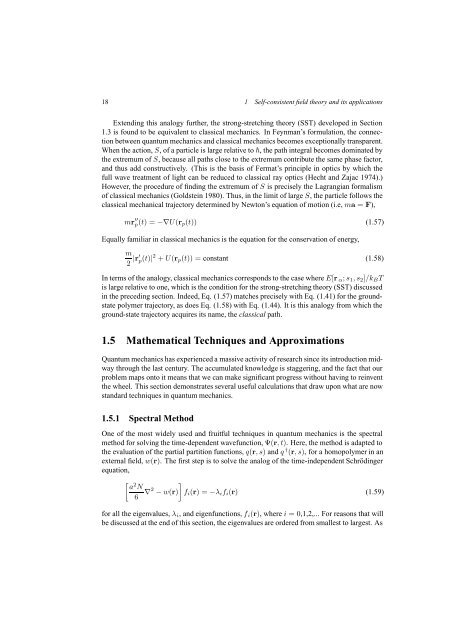Self-Consistent Field Theory and Its Applications by M. W. Matsen
Self-Consistent Field Theory and Its Applications by M. W. Matsen
Self-Consistent Field Theory and Its Applications by M. W. Matsen
You also want an ePaper? Increase the reach of your titles
YUMPU automatically turns print PDFs into web optimized ePapers that Google loves.
18 1 <strong>Self</strong>-consistent field theory <strong>and</strong> its applications<br />
Extending this analogy further, the strong-stretching theory (SST) developed in Section<br />
1.3 is found to be equivalent to classical mechanics. In Feynman’s formulation, the connection<br />
between quantum mechanics <strong>and</strong> classical mechanics becomes exceptionally transparent.<br />
When the action, S, of a particle is large relative to , the path integral becomes dominated <strong>by</strong><br />
the extremum of S, because all paths close to the extremum contribute the same phase factor,<br />
<strong>and</strong> thus add constructively. (This is the basis of Fermat’s principle in optics <strong>by</strong> which the<br />
full wave treatment of light can be reduced to classical ray optics (Hecht <strong>and</strong> Zajac 1974).)<br />
However, the procedure of finding the extremum of S is precisely the Lagrangian formalism<br />
of classical mechanics (Goldstein 1980). Thus, in the limit of large S, the particle follows the<br />
classical mechanical trajectory determined <strong>by</strong> Newton’s equation of motion (i.e, ma = F),<br />
mr ′′<br />
p(t) =−∇U(r p (t)) (1.57)<br />
Equally familiar in classical mechanics is the equation for the conservation of energy,<br />
m<br />
2 |r′ p (t)|2 + U(r p (t)) = constant (1.58)<br />
In terms of the analogy, classical mechanics corresponds to the case where E[r α ; s 1 ,s 2 ]/k B T<br />
is large relative to one, which is the condition for the strong-stretching theory (SST) discussed<br />
in the preceding section. Indeed, Eq. (1.57) matches precisely with Eq. (1.41) for the groundstate<br />
polymer trajectory, as does Eq. (1.58) with Eq. (1.44). It is this analogy from which the<br />
ground-state trajectory acquires its name, the classical path.<br />
1.5 Mathematical Techniques <strong>and</strong> Approximations<br />
Quantum mechanics has experienced a massive activity of research since its introduction midway<br />
through the last century. The accumulated knowledge is staggering, <strong>and</strong> the fact that our<br />
problem maps onto it means that we can make significant progress without having to reinvent<br />
the wheel. This section demonstrates several useful calculations that draw upon what are now<br />
st<strong>and</strong>ard techniques in quantum mechanics.<br />
1.5.1 Spectral Method<br />
One of the most widely used <strong>and</strong> fruitful techniques in quantum mechanics is the spectral<br />
method for solving the time-dependent wavefunction, Ψ(r,t). Here, the method is adapted to<br />
the evaluation of the partial partition functions, q(r,s) <strong>and</strong> q † (r,s), for a homopolymer in an<br />
external field, w(r). The first step is to solve the analog of the time-independent Schrödinger<br />
equation,<br />
[ a 2 ]<br />
N<br />
6 ∇2 − w(r) f i (r) =−λ i f i (r) (1.59)<br />
for all the eigenvalues, λ i , <strong>and</strong> eigenfunctions, f i (r), where i =0,1,2,... For reasons that will<br />
be discussed at the end of this section, the eigenvalues are ordered from smallest to largest. As
















